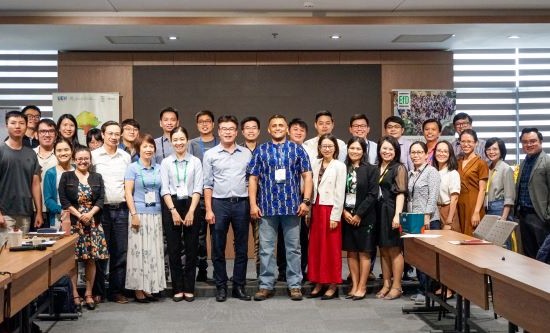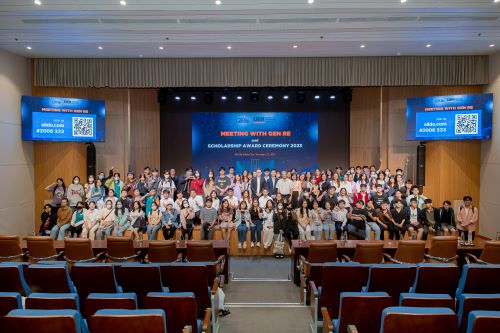Introduction of "Viet Nam Economic Prospects 2014: Institutions and Transparency"
The UEH introduced new publication "Viet Nam Economics's Prospects 2014: Institution and Transparency", this is a new pubilication and different from the previous prints. The questions here are: Where was this book from? How did people make it? What are its main content and highlights? How would they do that?
The UEH is on its way to become a research-oriented university. Therefore, scientific research is significantly important. Currently, the UEH has two research directions: the first is academic research to be published on ranked international journals and specialized scientific reviews and domestically well–recognized ones; the second is practical research to advice developing policies for decision makers & executioners from local to central government, from economic organizations to companies. This publication is a combination of both directions. In other words, the main objective is setting scientific foundations and arguments for Viet Nam current developing policies from University's academic point of view.
The UEH plans to annually issue a report of Viet Nam Economic Prospect. This annual report will mention about areas and policies in marcroeconomics, finance – banking, economic industries, as well as institutional and law aspects in economics and business. Due to their broad scale, the UEH only mentioned the most highlighted issues in each area. After discussing with scientists and lecturers, they all agreed that the focus of 2014 should be institutional reforms so the report was concentrated in "Institution and Transparency". After 6 months research, editorial group selected 8 articles represented this year theme. They are the work of 8 groups of lecturers from Economics, Finance, Public Finance, Banking and Law faculties. These articles were examined, reviewed, edited and unified the point of views in one publication.
In 2014, there are several controversial topics in these areas: in macroeconomics, the report mentioned the needs of change in growth model based from capital intensive to total factor productivity (TFP) and labor intensive to using trained labors; the relationship between growth and unequal income with growth for the poors; the issue of exchange policies and Viet Nam product competitiveness; reforming fiscal year space and public expenditure, etc. In banking and finance, the report focuses on new policies for gold market and solving bad debts in commercial banks. In 2014, the concentrated economic area is agriculture with issues in producing and trading farming products. Lastly, the economic institution reform this year has to prioritize the change in state–owned enterprises (SOE) and group owned by government as well as the reform in laws of encouraging private investment, from business registrating steps to divide, dissolve and bankruptcy.
This book emphasizes 2 key points:
Firstly, this report aims to consult policies in academic way. In fact, the print includes some researches with depth and quantitative economic models but the main target of report is consulting. There are two requirements. First, in spite of its academic aspects, the suggested policies must be closed to reality, easy to read, to understand, to apply with policy decision makers and executioners as well as businessman. On the other hand, because of its academic origin, these policies must have evidents, examples with strong arguments to be more convincing. For example, if you are interest in 2014 suggested growth policies, you can look at the summary report. However, if you are looking for the foundation of these policies, you should read article of macroeconomics, which suggested solving the growth paradox and increasing income gap between the poorest and the richest. The researchers had to analyze the massive amount of information with a sophisticated equation. Similarly, we should look at the exchange rate problem and Viet Nam product and services competitiveness. At first glance, people easily conclude the devaluation of domestic currency would increase the competitiveness of exporting goods. However, Viet Nam economics is far from that simple, when the researchers pointed out the exchange rate is also effected significantly by non-merchant goods such as energy, petrol, which are controlled strictly by government. This means, in certain situation, devaluation is necessary but it is not enough.
Secondly, the research result showed the UEH's expansion from training and research to public management and law study, which are strong points of our university in many years. The report suggested to government many policies as wel as managment methods under the condition of budget limitation, farming product management, gold market management, bad-debt management, and public expanditure management... Similarly, the report promote change in regulation of several areas and market, like if considering gold as money, the gold market should be viewed as part of monetary market and need to be managed by government documents rather than the State Bank policies; or if the assets of SOE belong to people, over 90 millions... the parliament should have more active role in the SOE reform or the reform instruction should be issued by Paliarment and the management of enormous assets from this reform should be handled by Paliarment.
With the high hope in being a policies communicating channel with scientific argument in the country development, this is the initial effort of the UEH. However, it is a clear example of the university social responsibility toward economic development. This publication still possesses some shortcommings but we are expecting to communicate with law formers, managers, businessman and media.
Thus, the UEH is honored to introduce: "Viet Nam Economic Prospects 2014: Institution and Transparency".

Assoc. Prof. Ho Viet Tien





